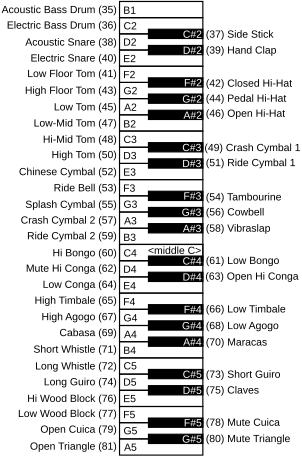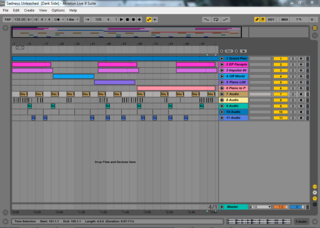Parameter interpretations
GM Instruments must also obey the following conventions for program and controller events:
Program change events
This section needs additional citations for verification .(January 2024) |
In MIDI, the instrument sound or "program" for each of the 16 possible MIDI channels is selected with the Program Change message, which has a Program Number parameter. The following table shows which instrument sound corresponds to each of the 128 possible GM Program Numbers. [3] There are 128 program numbers. The numbers can be displayed as values 1 to 128, or, alternatively, as 0 to 127. The 0 to 127 numbering is usually only used internally by the synthesizer; the vast majority of MIDI devices, digital audio workstations and professional MIDI sequencers display these Program Numbers as shown in the table (1–128).
Piano
- 1 Acoustic Grand Piano or Piano 1
- 2 Bright Acoustic Piano or Piano 2
- 3 Electric Grand Piano or Piano 3 (usually modeled after Yamaha CP-70)
- 4 Honky-tonk Piano
- 5 Electric Piano 1 (usually a Rhodes or Wurlitzer piano)
- 6 Electric Piano 2 (usually an FM piano patch, often chorused)
- 7 Harpsichord (often with a fixed velocity level)
- 8 Clavinet
Chromatic Percussion
- 9 Celesta
- 10 Glockenspiel
- 11 Music Box
- 12 Vibraphone
- 13 Marimba
- 14 Xylophone
- 15 Tubular Bells
- 16 Dulcimer or Santoor
Organ
- 17 Drawbar Organ or Organ 1
- 18 Percussive Organ or Organ 2
- 19 Rock Organ or Organ 3
- 20 Church Organ
- 21 Reed Organ
- 22 Accordion
- 23 Harmonica
- 24 Bandoneon or Tango Accordion
Guitar
In most synthesizer interpretations, guitar and bass sounds are set an octave lower than other instruments.
- 25 Acoustic Guitar (nylon)
- 26 Acoustic Guitar (steel)
- 27 Electric Guitar (jazz)
- 28 Electric Guitar (clean, often chorused, resembling a Stratocaster run through a Roland Jazz Chorus amplifier)
- 29 Electric Guitar ( muted )
- 30 Electric Guitar ( overdrive )
- 31 Electric Guitar ( distortion )
- 32 Electric Guitar ( harmonics )
Bass
- 33 Acoustic Bass
- 34 Electric Bass ( finger )
- 35 Electric Bass ( picked )
- 36 Electric Bass (fretless)
- 37 Slap Bass 1
- 38 Slap Bass 2
- 39 Synth Bass 1
- 40 Synth Bass 2
Strings
- 41 Violin
- 42 Viola
- 43 Cello
- 44 Contrabass
- 45 Tremolo Strings
- 46 Pizzicato Strings
- 47 Orchestral Harp
- 48 Timpani
Ensemble
- 49 String Ensemble 1 (often in marcato)
- 50 String Ensemble 2 (slower attack than String Ensemble 1)
- 51 Synth Strings 1
- 52 Synth Strings 2
- 53 Choir Aahs
- 54 Voice Oohs (or Doos )
- 55 Synth Voice or Synth Choir
- 56 Orchestra Hit
Brass
- 57 Trumpet
- 58 Trombone
- 59 Tuba
- 60 Muted Trumpet
- 61 French Horn
- 62 Brass Section
- 63 Synth Brass 1
- 64 Synth Brass 2
Reed
- 65 Soprano Sax
- 66 Alto Sax
- 67 Tenor Sax
- 68 Baritone Sax
- 69 Oboe
- 70 English Horn
- 71 Bassoon
- 72 Clarinet
Pipe
- 73 Piccolo
- 74 Flute
- 75 Recorder
- 76 Pan Flute
- 77 Blown bottle
- 78 Shakuhachi
- 79 Whistle
- 80 Ocarina
Synth Lead
- 81 Lead 1 (square, often chorused)
- 82 Lead 2 ( sawtooth or saw, often chorused)
- 83 Lead 3 ( calliope , usually resembling a woodwind)
- 84 Lead 4 (chiff)
- 85 Lead 5 (charang, a guitar-like lead)
- 86 Lead 6 (voice, derived from "synth voice" with faster attack)
- 87 Lead 7 ( fifths )
- 88 Lead 8 (bass and lead or solo lead or sometimes mistakenly called "brass and lead")
Synth Pad
- 89 Pad 1 ( new age , pad stacked with a bell, often derived from "Fantasia" patch from Roland D-50)
- 90 Pad 2 (warm, a mellower pad with slow attack)
- 91 Pad 3 (polysynth or poly , a saw-like percussive pad resembling an early 1980s polyphonic synthesizer)
- 92 Pad 4 ( choir , identical to "synth voice" with longer decay)
- 93 Pad 5 ( bowed glass or bowed , a sound resembling a glass harmonica)
- 94 Pad 6 (metallic, often created from a piano or guitar sample played with the attack removed)
- 95 Pad 7 (halo, choir-like pad, often with a filter effect)
- 96 Pad 8 ( sweep , pad with a pronounced "wah" filter effect)
Synth Effects
- 97 FX 1 ( rain , a bright pluck with echoing pulses that decreases in pitch)
- 98 FX 2 ( soundtrack , a bright perfect fifth pad)
- 99 FX 3 (crystal, a synthesized bell sound)
- 100 FX 4 (atmosphere, usually a classical guitar-like sound)
- 101 FX 5 ( brightness , bright pad stacked with choir or bell)
- 102 FX 6 ( goblins , a slow-attack pad with chirping or murmuring sounds)
- 103 FX 7 ( echoes or echo drops , similar to "rain")
- 104 FX 8 ( sci-fi or star theme, usually an electric guitar-like pad)
Ethnic
Percussive
- 113 Tinkle Bell
- 114 Agogô or cowbell
- 115 Steel Drums
- 116 Woodblock
- 117 Taiko Drum or Surdo
- 118 Melodic Tom
- 119 Synth Drum (a synthesized tom-tom derived from Simmons electronic drum)
- 120 Reverse Cymbal
Sound Effects
- 121 Guitar Fret Noise
- 122 Breath Noise
- 123 Seashore
- 124 Bird Tweet
- 125 Telephone Ring
- 126 Helicopter
- 127 Applause
- 128 Gunshot
Percussion

In GM standard MIDI files, channel 10 is reserved for percussion instruments only. [3] Notes recorded on channel 10 always produce percussion sounds when transmitted to a keyboard or synth module which uses the GM standard. Each distinct note number specifies a unique percussive instrument, rather than the sound's pitch.
If a MIDI file is programmed to the General MIDI protocol, then the results are predictable, but timbre and sound fidelity may vary depending on the quality of the GM synthesizer. The General MIDI standard includes 47 percussive sounds, using note numbers 35-81 (of the possible 128 numbers from 0–127), as follows: [3]
- 35 Acoustic Bass Drum or Low Bass Drum
- 36 Electric Bass Drum or High Bass Drum
- 37 Side Stick
- 38 Acoustic Snare
- 39 Hand Clap
- 40 Electric Snare or Rimshot
- 41 Low Floor Tom
- 42 Closed Hi-hat
- 43 High Floor Tom
- 44 Pedal Hi-hat
- 45 Low Tom
- 46 Open Hi-hat
- 47 Low-Mid Tom
- 48 High-Mid Tom
- 49 Crash Cymbal 1
- 50 High Tom
- 51 Ride Cymbal 1
- 52 Chinese Cymbal
- 53 Ride Bell
- 54 Tambourine
- 55 Splash Cymbal
- 56 Cowbell
- 57 Crash Cymbal 2
- 58 Vibraslap
- 59 Ride Cymbal 2
- 60 High Bongo
- 61 Low Bongo
- 62 Mute High Conga
- 63 Open High Conga
- 64 Low Conga
- 65 High Timbale
- 66 Low Timbale
- 67 High Agogô
- 68 Low Agogô
- 69 Cabasa
- 70 Maracas
- 71 Short Whistle
- 72 Long Whistle
- 73 Short Guiro
- 74 Long Guiro
- 75 Claves
- 76 High Woodblock
- 77 Low Woodblock
- 78 Mute Cuica
- 79 Open Cuica
- 80 Mute Triangle
- 81 Open Triangle
The standard does not specify program change numbers for different drum sets.
Controller events
In MIDI, adjustable parameters for each of the 16 possible MIDI channels may be set with the Control Change (CC) message, which has a Control Number parameter and a Control Value parameter (expressed in a range from 0 to 127). GM also specifies which operations should be performed by multiple Control Numbers. [1] [4]
|
RPN
GM defines several Registered Parameters, which act like Controllers but are addressed in a different way. In MIDI, every Registered Parameter is assigned a Registered Parameter Number or RPN. Registered Parameters are usually called RPNs for short. [5]
Setting Registered Parameters requires sending (numbers are decimal):
- two Control Change messages using Control Numbers 101 and 100 to select the parameter, followed by
- any number of Data Entry messages of one or two bytes (MSB = Controller #6, LSB = Controller #38), and finally
- an "End of RPN" message
The following global Registered Parameter Numbers (RPNs) are standardized [6] (the parameter is specified by RPN LSB/MSB pair and the value is set by Data Entry LSB/MSB pair):
- 0,0 Pitch bend range
- 1,0 Channel Fine tuning
- 2,0 Channel Coarse tuning
An example of an RPN control sequence to set coarse tuning to A440 (parm 2, value 64) is 101:0, 100:2, 6:64, 101:127, 100:127.
System Exclusive messages
Two GM System Exclusive ("SysEx") messages are defined: one to enable and disable General MIDI compatibility mode (for synthesizers that also have non-GM modes); and the other to set the synthesizer's master volume.














